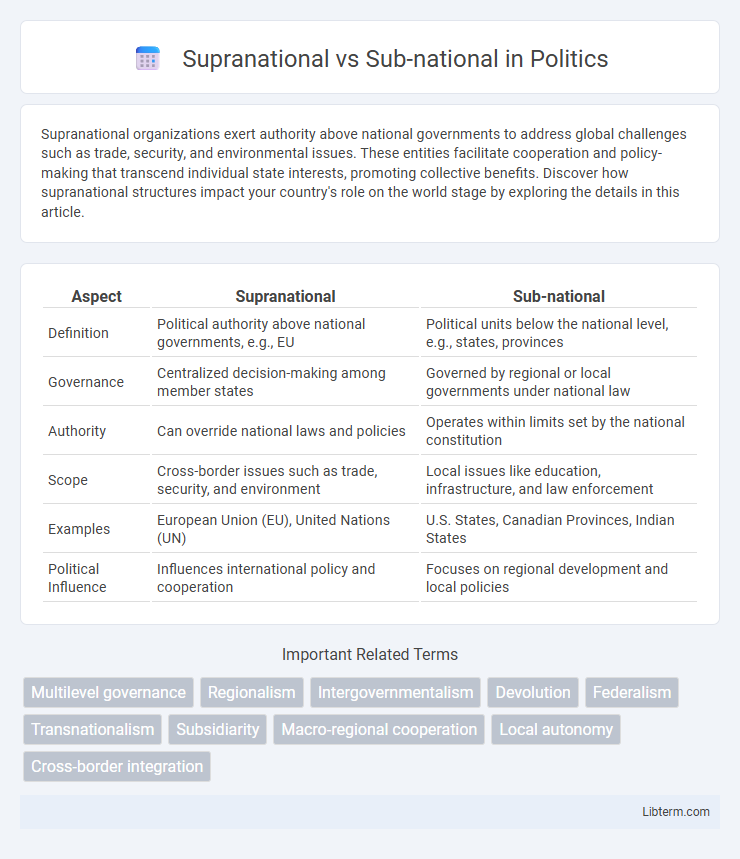Supranational organizations exert authority above national governments to address global challenges such as trade, security, and environmental issues. These entities facilitate cooperation and policy-making that transcend individual state interests, promoting collective benefits. Discover how supranational structures impact your country's role on the world stage by exploring the details in this article.
Table of Comparison
| Aspect | Supranational | Sub-national |
|---|---|---|
| Definition | Political authority above national governments, e.g., EU | Political units below the national level, e.g., states, provinces |
| Governance | Centralized decision-making among member states | Governed by regional or local governments under national law |
| Authority | Can override national laws and policies | Operates within limits set by the national constitution |
| Scope | Cross-border issues such as trade, security, and environment | Local issues like education, infrastructure, and law enforcement |
| Examples | European Union (EU), United Nations (UN) | U.S. States, Canadian Provinces, Indian States |
| Political Influence | Influences international policy and cooperation | Focuses on regional development and local policies |
Introduction to Supranational and Sub-national Entities
Supranational entities, such as the European Union, are organizations where member states cede some sovereignty to achieve common goals beyond national boundaries. Sub-national entities refer to administrative divisions within a country, including states, provinces, or regions, each possessing varying degrees of legislative and executive powers. Understanding the distinction between supranational cooperation and sub-national administration is essential for analyzing governance structures in global and domestic contexts.
Defining Supranational Organizations
Supranational organizations refer to entities formed by multiple countries that delegate authority to a higher body, enabling collective decision-making beyond national borders. These organizations possess the power to enforce agreements and policies that member states must adhere to, often facilitating cooperation on economic, political, and social issues. Key examples include the European Union (EU), the United Nations (UN), and the World Trade Organization (WTO), which exemplify the transfer of sovereignty from individual nations to an overarching institution.
Understanding Sub-national Units
Sub-national units refer to administrative divisions within a sovereign state, such as states, provinces, or regions, which possess varying degrees of governmental authority. These units manage localized governance, implementing policies tailored to their demographic, economic, and cultural contexts, often functioning under the legal framework established by the central government. Understanding sub-national structures is essential for analyzing decentralized political systems, resource allocation, and regional development strategies.
Key Differences Between Supranational and Sub-national
Supranational entities operate above the nation-state level, exercising authority that transcends individual countries, exemplified by organizations like the European Union which enforce binding regulations on member states. Sub-national units, such as states, provinces, or regions within a country, derive their powers from the national government and are subject to its ultimate sovereignty. The key differences lie in the scope of authority, legal autonomy, and governance, with supranational bodies having cross-border jurisdiction and sub-national entities functioning within the framework of their respective nations.
Historical Development of Supranational and Sub-national Governance
Supranational governance emerged in the mid-20th century, driven by efforts to prevent conflict and promote cooperation through institutions like the European Union, which transferred sovereignty from nation-states to a higher authority. In contrast, sub-national governance has deeper historical roots reflecting the decentralization of power within countries, seen in federal systems such as the United States and Germany that delegate authority to states or regions. The historical development of supranational bodies highlights international integration trends, while sub-national governance reflects evolving domestic political and administrative needs.
Examples of Supranational Organizations
Supranational organizations like the United Nations (UN), European Union (EU), and World Trade Organization (WTO) operate above individual nation-states, facilitating cooperation on global issues such as security, trade, and human rights. These entities possess authority that can transcend national borders, enabling member states to cede certain sovereign powers for collective decision-making and enforcement. In contrast, sub-national entities include regional governments, states, or provinces that operate within the legal frameworks of their respective nations without supranational authority.
Case Studies of Sub-national Regions
Sub-national regions such as Catalonia, Scotland, and Quebec demonstrate varying degrees of autonomy in governance, legal systems, and cultural policies, offering critical insights into the complexity of decentralized power within nation-states. These case studies reveal how sub-national entities negotiate fiscal control, language preservation, and political representation while balancing national unity and regional identity. Examining their unique legal frameworks and political movements illustrates the challenges and opportunities in managing sub-national diversity under overarching sovereign structures.
Governance Structures and Power Distribution
Supranational governance structures involve multiple countries ceding authority to a higher organization, enabling collective decision-making and policy enforcement beyond national borders, as seen in entities like the European Union. Sub-national governance refers to administrative divisions within a single country, such as states, provinces, or municipalities, where power is distributed to local authorities with varying degrees of autonomy based on constitutional or legislative frameworks. The distribution of power in supranational systems prioritizes regional integration and shared sovereignty, while sub-national governance emphasizes local control and tailored policy implementation within national legal boundaries.
Advantages and Challenges of Each System
Supranational systems offer advantages such as streamlined decision-making across multiple countries and unified policies that enhance economic and political cooperation. Challenges include loss of sovereignty for member states and complexities in balancing diverse national interests. Sub-national systems provide localized governance tailored to regional needs, promoting cultural autonomy and more direct citizen participation, but face difficulties in coordination, resource allocation, and potential policy fragmentation.
Future Trends in Multilevel Governance
Future trends in multilevel governance highlight increasing integration of supranational institutions to address global challenges like climate change and migration, enhancing cooperation beyond traditional national borders. Sub-national entities, including regions and municipalities, are gaining autonomy and influence, leveraging digital innovation and localized policy experimentation to respond more effectively to citizen needs. This dynamic fosters a complex, adaptive governance architecture where power is distributed across multiple layers, promoting resilience and inclusivity in decision-making processes.
Supranational Infographic

 libterm.com
libterm.com